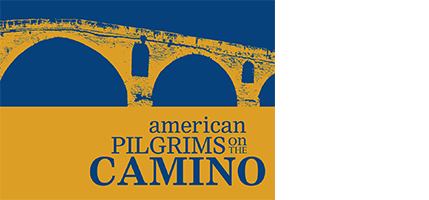Where to Sleep on the Camino: Albergues and More
Where to sleep on the Camino runs the gamut from modest albergues to small inns and historic hotels. Deciding where to stay is a very personal decision, but a hard one to make if you’re unfamiliar with the various different types of accommodation on the Camino. This article will help you with that.
These tips on where to sleep on the Camino will explain the various lodging types (and what they typically offer) along with some common FAQs.
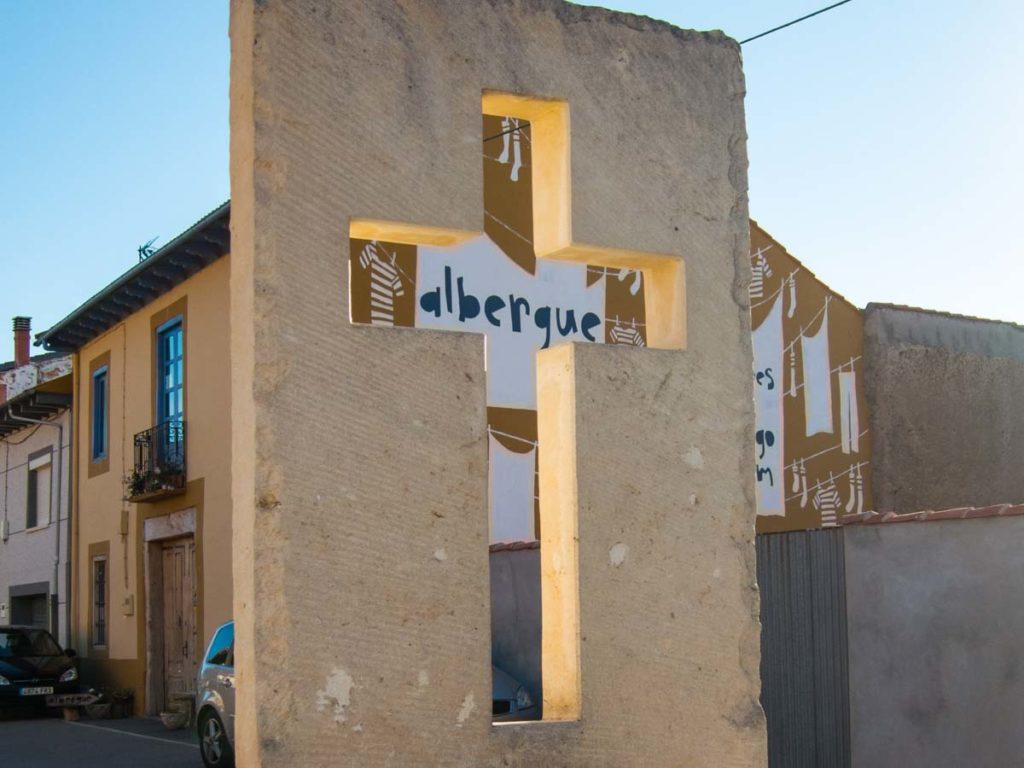
What follows are some brief descriptions of the different types of accommodations, ordered roughly by cost-per-night. We aren’t recommending specific, or favorite lodgings, but if you want recommendations, be sure to ask in our Facebook group.
Albergues on the Camino
Albergues are traditional pilgrim hostels. They promise a modest lodging with a bed, bathroom and sometimes food service. This isn’t the typical “party hostel” from your college trip abroad. Albergues are reserved specifically for pilgrims and you must show your credential in order to stay in one. Even if you normally stay in hotels or are unsure if you can deal with a shared bunkroom, we do encourage you to consider the albergue. They offer a unique camaraderie and hospitality that’s difficult to replicate elsewhere.
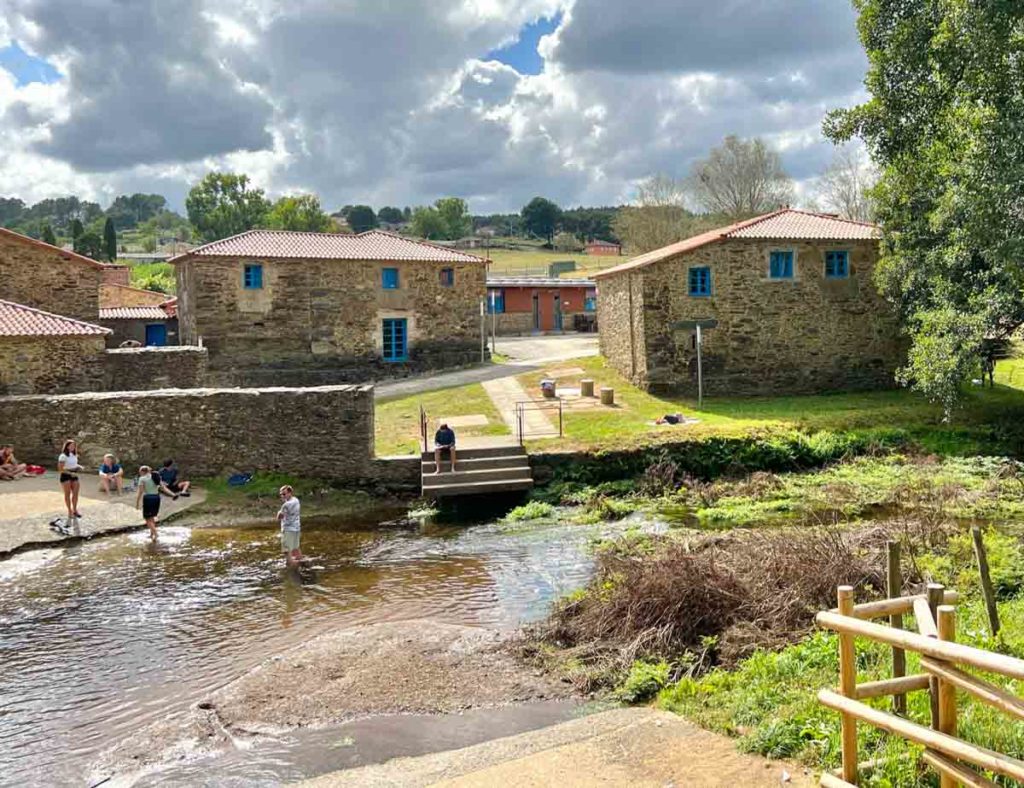
You’ll note below that we are using words like “often” or “sometimes” to describe the services offered. This is because every albergue offers their own unique take on pilgrim hospitality. Have a careful look the Camino guidebooks and apps to find individual listings with detailed descriptions.
There are three types of albergues:
Municipal or Parochial Albergues
- Cost: €7-14
- Bed Type: Nearly always a shared room with bunk beds, occasionally single beds
- Bathroom: Shared bathrooms
- Food: Some offer a group meal, most have kitchen facilities
- Accept Reservations: No (with very few exceptions)
These albergues are run by local churches, monasteries, convents, municipalities or Camino associations. They’re always the budget choice. The bed situation is usually very modest, and they don’t accept portaged bags. But they can also provide a great experience with a group meal, special church or music service, or historical buildings.
With the help of one of our grants, a new albergue was recently opened Madrid. They have limited space, but are offering preferential consideration for American Pilgrims members. Log into your account and get details here for how to request a reservation.
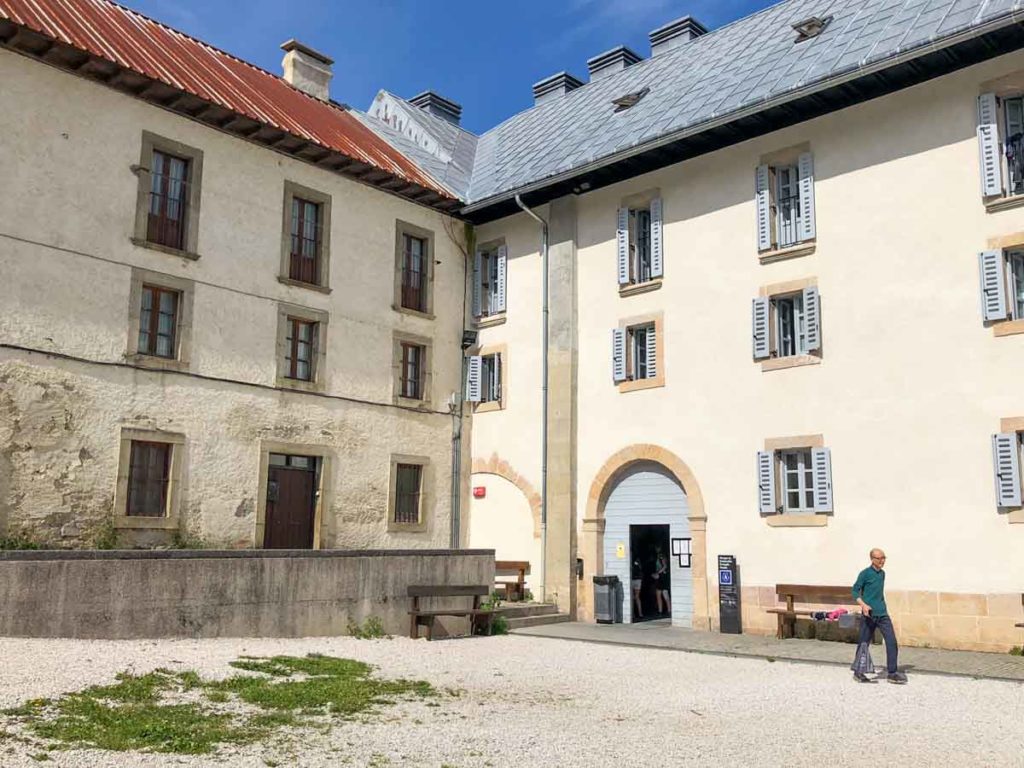
Private Albergues
- Cost: €14-25
- Bed Type: Shared room with bunk beds, some offer private rooms
- Bathroom: Shared bathrooms, some offer private baths
- Food: Usually have kitchen facilities, an attached cafe and/or group meals
- Accept Reservations: Most
These albergues are private businesses ranging from rustic to modern. Most will accept a portaged bag. They don’t usually offer special musical or church services, but they sometimes have very comfortable lounge rooms or outdoor spaces.
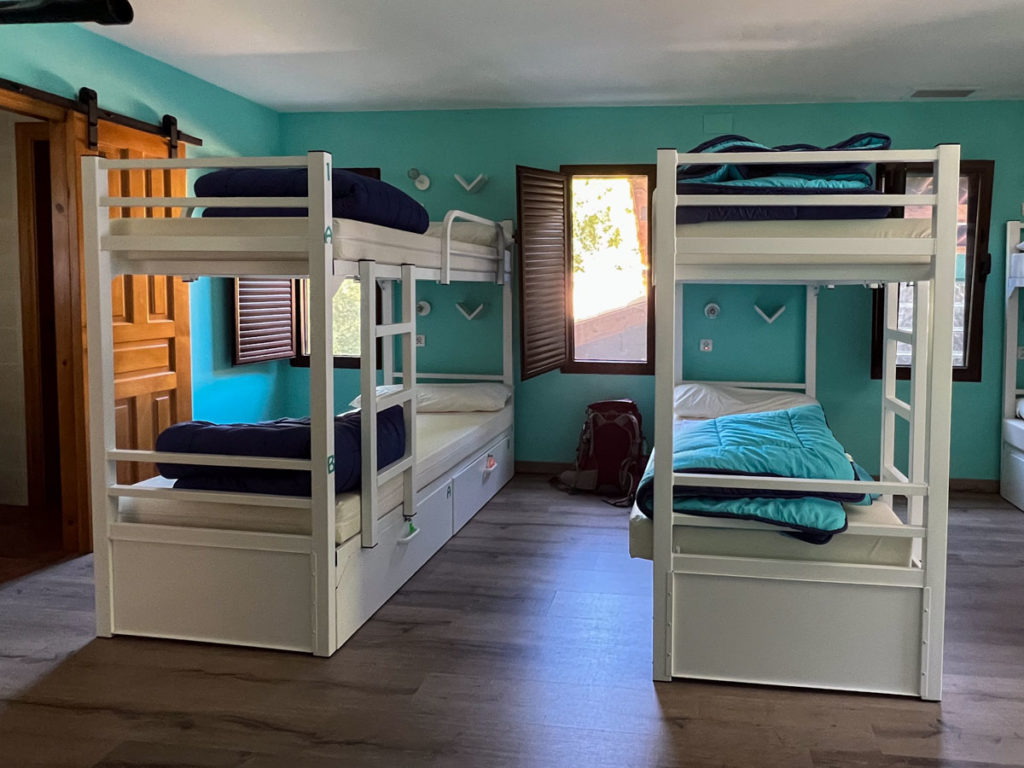
Donativo Albergues
- Cost: Pay what you can
- Bed Type: Shared room with bunk beds
- Bathroom: Shared bathrooms
- Food: Often offer either breakfast and/or group dinners
- Accept Reservations: Not usually
“Donativo” means “donation” in Spanish. These albergues offer the most traditional kind of hospitality, relying on an honor system for payment. Donativos are billed as “pay what you can”, but please don’t think they’re free. What you donate helps them accommodate pilgrims who come after you. So think of it as a “pay it forward” to support those who walk in the door tomorrow.
The donativos are usually municipal or parochial, but there are some really spectacular private ones as well. The lodgings are usually modest, but the welcome is always big, and some of the settings and group meals are legendary.
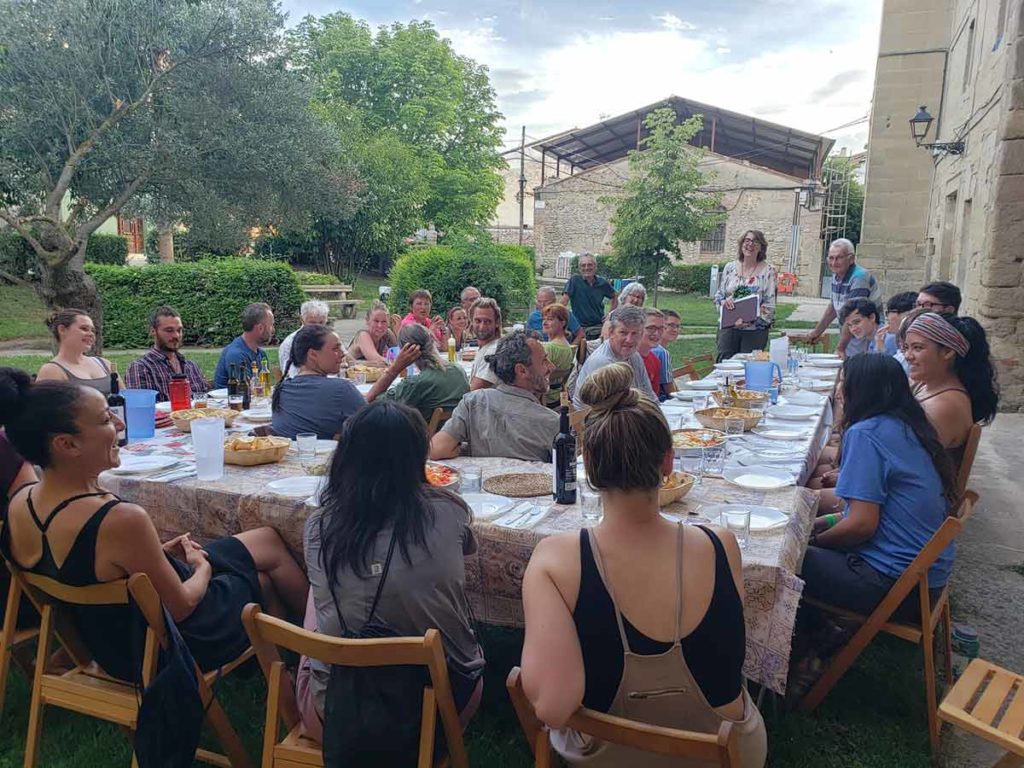
Albergue FAQ
How do I Check-in?
The Spanish government requires lodgings to collect certain information on their guests. This includes passport/ID numbers, name, address, birthdate and the like. Some albergues will just collect it from you when you arrive. But in order to speed up the process, two systems have been created which allow you to pre-fill the information. One is called Aloha2 and the other is Pilgrim Pass.
With Pilgrim Pass, you fill out your info in advance and receive a QR code. The albergue then uses that code to shortcut your check-in.
With Aloha2, you can’t pre-fill it before you go to Spain. Rather, you’ll scan the Aloha2 QR code on-site, fill in your info and THEN you’ll receive your own QR code, which the albergue uses to check you in.
In both cases, you’ll want to screenshot your personal QR code because you can re-use it at other lodgings that use that particular system.
Here’s the confusing part– you now have two different personal QR codes to keep track of. Some places will take one, some the other, and some will use neither.
Are the Albergues Noisy?
Any bunkhouse will carry the noise of tossing, turning, and snoring. You can mitigate it with eye masks and earplugs. Although many pilgrims report that they’re often too tired to be bothered by it. As a courtesy to others, do not make a great deal of noise as you prepare to leave in the morning.
Are Albergues Gender Segregated?
The sleeping rooms are nearly always mixed-gender. The bathrooms are often segregated, but the configurations can vary quite a bit.
Do Albergues Provide Bedding?
The most typical scenario is that they will offer disposable sheets, which helps with hygiene and bed bugs. Most private albergues and some municipals offer blankets, but you can’t bank on it. Group consensus suggests that you bring a lightweight sleeping bag, camp blanket or sleep sack, rated for the time of year when you’ll be going.
Do Albergues Provide Electrical Plugs
Newer or newly updated buildings will often have a plug next to or near the bed. In older buildings, you’ll have to share. Bring an EU “type C” plug adapter.
Are There Laundry Facilities?
All albergues have at least an area for hand washing your clothes and drying them on a line. Increasingly, they offer washing machines, and occasionally dryers. Most larger towns also have laundromats.
Other Types of Lodgings
Hostales (or Pensiones)
- Cost: €35-70
- Bed Type: Private room
- Bathroom: Private or shared bath
- Food: Some offer breakfast
- Accept Reservations: Yes
A “hostel” is what we would consider a group or youth hostel (ref: aforementioned college abroad). A “hostal” (sometimes called a “pension”) is an independently run small hotel or guesthouse. We don’t have a lot of this kind of lodging in the US, but they are prevalent on the Camino and can be a great deal for someone looking for a private room. Expect a clean but modest bed/bath. Rooms are available for singles, doubles and families.
Check locations carefully to make sure that the hostal isn’t too far off the route.
Casas Rurales
- Cost: €55-150
- Bed Type: Private room
- Bathroom: Private bath (usually)
- Food: Usually offer breakfast and/or dinner
- Accept Reservations: Yes
“Casa Rural” means “rural house”. Visualize a countryside B&B. These properties can be quite special, often featuring a restored historic building, farm fresh food, or lovely settings.
Check locations carefully to make sure that they aren’t too far off the route.
Hotels
- Cost: €65-180
- Bed Type: Private room
- Bathroom: Private bath
- Food: Usually offer breakfast, and sometimes half-board with dinner
- Accept Reservations: Yes
Most of the larger towns and cities will have traditional or chain hotels. With these lodgings, you’re more likely to be sharing your space with tourists and business travelers. They also usually offer amenities such as a pool, serviced front desk or restaurant.
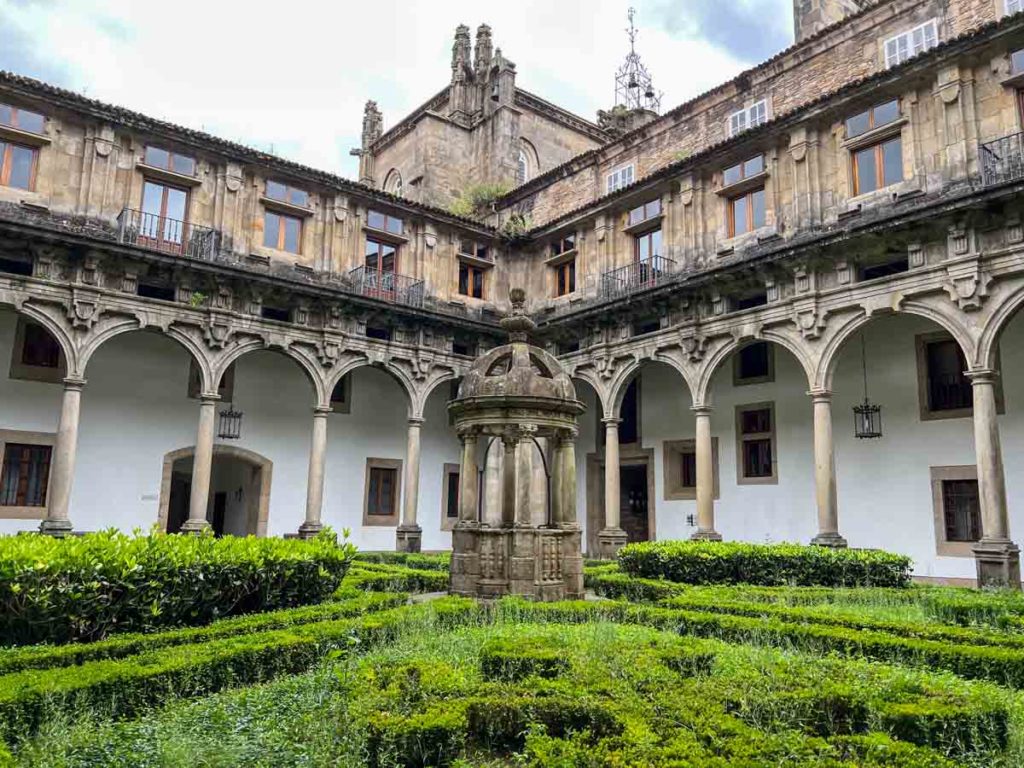
Paradores
A Parador is a historic building that’s been converted into a luxury hotel. The one in Santiago was actually funded by Queen Isabella in 1499 and functioned as a pilgrim hostel. Paradores offer a splurge stay for the weary pilgrim and are surprisingly affordable by US standards.
- Cost: €200-250, discount available with pilgrim credential
- Bed Type: Private room
- Bathroom: Private bath
- Food: Usually offer breakfast
- Accept Reservations: Yes
General Accommodation FAQ
Do I Need Reservations?
This is a highly personal matter. Some folks prefer the peace of mind that comes with booking ahead. Others don’t want to be locked into a set schedule and prefer to do things on the fly, trusting that the “Camino will provide.”
If you walk or bike a popular Camino route from May to September, or during a major Spanish holiday, things can and do get busy. Often people book the first few nights and then see how it goes. Other people prefer to walk off of the typical guidebook stages, which helps to avoid choke-points in busy towns.
How do I Reserve and Pay For Lodgings?
Among those albergues who take reservations, there are several ways that you can reserve them. Prepare to be flexible as methods vary quite a bit.
- Reserve through a service like Booking.com. Some albergues and most other types of lodgings list their bed inventory on aggregator services like Booking. They may list all beds, some beds or just private beds. Booking.com is convenient, but not a be-all source for beds. With Booking, the cancellation and payment policies will vary. And expect to pay a few € more than reserving directly.
- Reserve direct and pay on the lodgings website. Some lodgings have their own systems for booking. You’ll pre-pay using a credit card or Google/Apple pay. Sometimes you do this directly from their website. And sometimes you contact them on Whatsapp and they’ll send you a link to reserve and pay.
- Reserve direct and hold bed on your word. This works for some albergues but usually not other types of lodging. You can use Whatsapp or a phone call to inquire about availability and they’ll then hold a bed on your word. This system usually requires that you a) arrive by a certain time, and/or b) message them the day-of to reconfirm or let them know if you’re running late. Never book a bed this way and then no-show. It hurts their business and takes opportunities away from other weary pilgrims.
As for payment The donativos and many of the municipal albergues only accept cash. Some private albergues prefer cash but can take a card. So, bring a card but also get periodic cash infusions from an ATM.
Also note that many of the smaller places close down for the winter and won’t accept reservations until the spring season opens.
Are There Bedbugs?
There can be, but they aren’t always an issue. Or they may affect some people, but not others. Your best defense is to learn what to look for.
As a preventative measure, many pilgrims prefer to spray the inside of their backpack and the outside of their sleep sack with a pesticide, such as Permethrin.
How Do I Keep My Belongings Safe?
The Camino is a very safe and trusting place. But petty theft can happen. And it’s not uncommon for tired pilgrims to lose belongings. The albergues seldom provide lockers. So, most pilgrims keep track of their wallets and passports by keep them on their person when out and about.
Keeping your belongings tidy and in your pack will discourage theft and make it less likely that you’ll accidentally leave something behind in the morning.
More Camino Planning Resources
- Choose a route using our route overview page.
- FAQ for planning your pilgrimage.
- What to expect while on the Camino.
- Order your credential in advance from us.
- Figure out what to pack.
Your MEMBERSHIP in American Pilgrims on the Camino makes it possible for everyone to make the pilgrimage that is best for them. Thanks, as always, for your support and if you aren’t already a member, you can become one here.
Rev 05/04/2025

